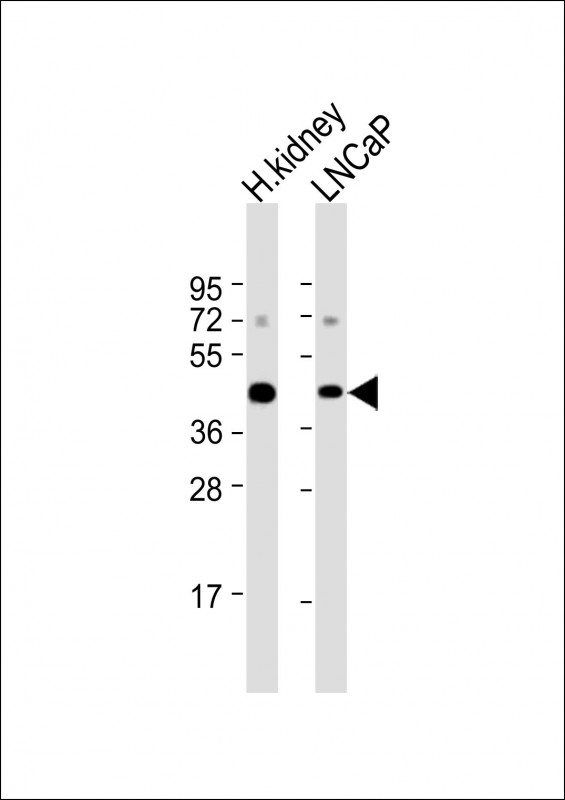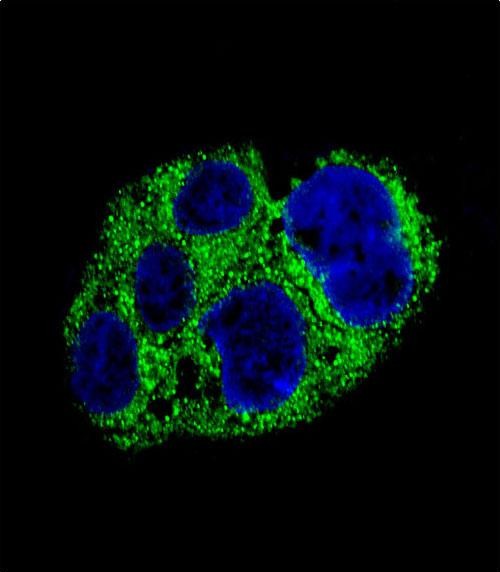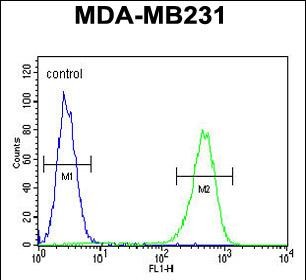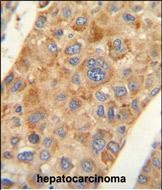




| WB | 1/1000 | Human,Mouse,Rat |
| IF | 咨询技术 | Human,Mouse,Rat |
| IHC | 1/100-1/500 | Human,Mouse,Rat |
| ICC | 1/10-1/50 | Human,Mouse,Rat |
| FCM | 1/10-1/50 | Human,Mouse,Rat |
| Elisa | 咨询技术 | Human,Mouse,Rat |
| Aliases | Alpha-methylacyl-CoA racemase, 2-methylacyl-CoA racemase, AMACR |
| Entrez GeneID | 23600 |
| WB Predicted band size | 42.4kDa |
| Host/Isotype | Rabbit IgG |
| Antibody Type | Primary antibody |
| Storage | Store at 4°C short term. Aliquot and store at -20°C long term. Avoid freeze/thaw cycles. |
| Species Reactivity | Human |
| Immunogen | This AMACR antibody is generated from rabbits immunized with a KLH conjugated synthetic peptide between 323-351 amino acids from the C-terminal region of human AMACR. |
| Formulation | Purified antibody in PBS with 0.05% sodium azide. |
+ +
以下是关于AMACR抗体的3篇参考文献及其摘要:
1. **《Alpha-methylacyl-CoA racemase: a novel tumor marker in prostate cancer》**
- **作者**: Luo J, Zha S, Gage WR 等
- **摘要**: 该研究首次提出AMACR作为前列腺癌特异性生物标志物。通过免疫组化分析,发现AMACR在前列腺癌组织中高表达,而在良性前列腺组织中几乎不表达,表明其抗体在病理诊断中具有重要价值。
2. **《Expression of α-methylacyl-CoA racemase (AMACR) in various malignant neoplasms》**
- **作者**: Jiang Z, Woda BA, Wu CL 等
- **摘要**: 研究比较了AMACR在多种癌症中的表达,发现前列腺癌和结肠癌中AMACR抗体染色阳性率显著高于其他癌症,提示其在鉴别转移性前列腺癌中的应用潜力。
3. **《α-Methylacyl-CoA racemase (AMACR) in prostate cancer: a tissue microarray study》**
- **作者**: Rubin MA, Zhou M, Dhanasekaran SM 等
- **摘要**: 利用组织芯片技术对前列腺癌样本进行大规模分析,证实AMACR抗体检测可显著提高前列腺癌诊断特异性,并探讨其与基底细胞标志物联合使用的临床意义。
4. **《Diagnostic utility of AMACR in prostate cancer: a meta-analysis》**
- **作者**: Evans AJ, Humphrey PA 等
- **摘要**: 通过荟萃分析评估AMACR抗体在前列腺癌诊断中的敏感性和特异性,结果显示其敏感性超过90%,但强调需结合其他标记物以避免假阴性(如某些高级别癌变)。
**Background of AMACR Antibody**
Alpha-methylacyl-CoA racemase (AMACR), also known as P504S, is a mitochondrial and peroxisomal enzyme that plays a critical role in lipid metabolism by catalyzing the conversion of branched-chain fatty acids and bile acid intermediates. Discovered in the early 2000s, AMACR gained prominence as a diagnostic biomarker due to its overexpression in cancers, particularly prostate adenocarcinoma. Unlike normal or benign tissues, which exhibit low AMACR expression, malignant cells show elevated levels, making it a valuable target for immunohistochemical (IHC) staining.
AMACR antibodies are widely used in pathology to distinguish prostate cancer from benign conditions (e.g., prostatic hyperplasia) in biopsy samples. Their specificity and sensitivity have made them a cornerstone in diagnostic panels alongside markers like basal cell markers (e.g., p63) to confirm malignancy. Beyond prostate cancer, AMACR overexpression is observed in other cancers, including renal cell carcinoma, colorectal carcinoma, and hepatocellular carcinoma, though its utility varies across tumor types.
The development of AMACR antibodies stemmed from gene expression profiling studies, which highlighted its role in cancer cell metabolism. While its biological function in oncogenesis remains under investigation, AMACR is thought to support tumor growth by modulating energy production from lipid sources. Despite its diagnostic value, interpretation requires caution, as some non-neoplastic tissues (e.g., nephrogenic adenoma) may also express AMACR. Ongoing research explores its prognostic potential and therapeutic implications in precision oncology.
×